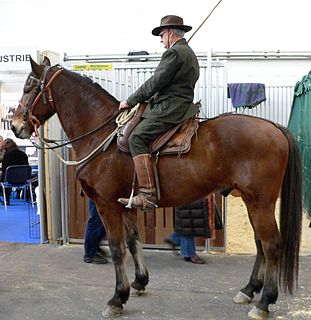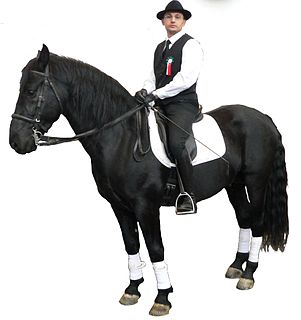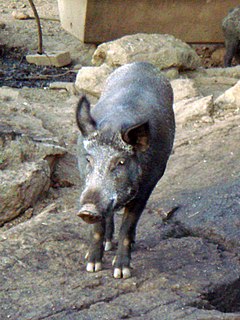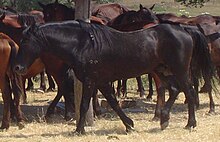
The Maremma is a coastal area of western central Italy, bordering the Tyrrhenian Sea. It includes much of south-western Tuscany and part of northern Lazio. It was formerly mostly marshland, often malarial, but was drained by order of Fernando I de' Medici.

A buttero or cavalcante is a mounted herder, usually of horses, of cattle, or of buffaloes, in Italy, predominantly in the Maremma region of Tuscany and northern Lazio, or in the Pontine Marshes to the south.

The Maremmano-Abruzzese Sheepdog, Italian: Cane da pastore Maremmano-Abruzzese, also called Maremmano, Maremma Sheepdog or Abruzzese Sheepdog, is an Italian breed of livestock guardian dog. It is indigenous to central Italy, particularly to Abruzzo and to the Maremma region of Tuscany and Lazio. It has been used for centuries by Italian shepherds to guard sheep from wolves. The literal English translation of the name is "shepherd dog of the Maremma and Abruzzo". The English name of the breed derives from that of the Maremma marshlands where, until recently, shepherds, dogs and hundreds of thousands of sheep over-wintered, and where the dogs are still abundant although sheep-farming has decreased substantially. It is widely employed in Abruzzo, where sheep herding remains vital to the rural economy and the wolf remains an active and protected predator.

The Maremmano is a breed of horse originating in the Maremma area of Tuscany and northern Lazio in Italy. Traditionally a hardy working horse used by the Butteri for livestock management, it is today principally a saddle horse. Extensive crossing with Thoroughbred and other breeds has led to a more athletic type, the Maremmano migliorato, or "Improved Maremmano".

The Murgese horse originated in the Murge, Apulia area of Italy during the Spanish rule, and was developed from Barb and Arabian horses. They are a hardy breed that is used mainly for cross-country riding, although they have also been used for light draft work.

The Maremmana is a breed of cattle reared in the Maremma, a former marshland region in southern Tuscany and northern Lazio in central Italy. It is raised principally in the provinces of Grosseto, Rome and Viterbo.

The Neapolitan Horse, Italian: (Cavallo) Napoletano, Neapolitano or Napolitano, is a horse breed that originated in the plains between Naples and Caserta, in the Campania region of Italy, but which may have been bred throughout the Kingdom of Naples. The Neapolitan horse was frequently mentioned in literature from the 16th to the 19th centuries, and is noted for its quality. Corte wrote in 1562: "in Italy the horses of the Kingdom of Naples are greatly esteemed; [there] many fine coursers are born ... suitable for use in war and in the manège and for every service that the rider may require". The decline of the breed was noted in the early 20th century by Mascheroni (1903) and Fogliata (1908). Some sources state that by 1950, the original Neapolitan horse was deemed extinct, but its lines were incorporated into other breeds, most notably the Lipizzaner. However, a breed called the Napolitano exists in Italy today, and is recognized by the Italian government. According to Gouraud, "a dedicated breeder ... is hoping to be able to rebuild it". La Repubblica reports that the attempt is based on a single stallion, Neapolitano "Il Vecchio", which belonged as a foal to Marshal Tito and passed when old to a Serbian farmer, from whom it was purchased and imported to Italy in 1989.

The Tolfetano or Cavallo Tolfetano is a breed of horse from the northern part of the Lazio region of Italy. It is indigenous to the Monti della Tolfa range of hills which lie within the Maremma Laziale, and which give the breed its name. The harsh terrain and limited resources of the area are thought to have contributed to the resistant and frugal nature of the breed.
The Segugio dell'Appennino or Piccolo Lepraiolo Italiano is a breed of small Italian scenthound, bred specifically to hunt hare. It may be either smooth-haired or wire-haired. It received full recognition from the Ente Nazionale della Cinofilia Italiana in 2010. It is one of four Italian breeds of scenthound, the others being the Segugio Italiano a Pelo Forte, the Segugio Italiano a Pelo Raso and the Segugio Maremmano.

The Segugio Maremmano is an Italian breed of scent hound from the coastal plains of the Maremma, in Tuscany. It is mainly used for hunting wild boar, but may also be used to hunt hare and other mammals. They may be either smooth-haired or rough-haired.

The Esperia Pony is a breed of pony originating in the area of the Aurunci Mountains and Ausoni Mountains near Esperia in the province of Frosinone, in the Lazio region of Italy. It is one of the fifteen indigenous horse "breeds of limited distribution" recognised by the AIA, the Italian breeders' association. It is the only Italian breed to be officially denominated a pony.
The Catria Horse is a breed of horse originating in the mountainous area of the massif of Monte Catria in the Marche region of Italy, and surrounding areas in the provinces of Ancona, Perugia and Pesaro. It is one of the fifteen indigenous horse "breeds of limited distribution" recognised by the AIA, the Italian breeders' association.
The Sarcidano, Italian: Cavallo del Sarcidano, is a rare Italian breed of semi-feral horse originating from the Altopiano del Sarcidano in the comune of Laconi, in Oristano Province of the Mediterranean island of Sardinia. It is one of the fifteen indigenous horse "breeds of limited distribution" recognised by the AIA, the Italian breeders' association.
The Samolaco is a rare breed of horse originating from the Valchiavenna and Valtellina, in Lombardy, northern Italy. It takes its name from the town of Samolaco, near Chiavenna in the province of Sondrio. Gravely endangered, it is not among the fifteen indigenous horse "breeds of limited distribution" recognised by the AIA, the Italian breeders' association. The population is listed in DAD-IS as over 12 in 1994, and under 100 in 1998; one further example of the breed may have been identified during a television broadcast.
The Garfagnina is a cattle breed from Tuscany in central Italy. It is one of the 16 minor Italian cattle breeds of limited diffusion recognised and protected by the Ministero delle Politiche Agricole Alimentari e Forestali, the Italian ministry of agriculture.
The Sardo Bruna is a breed of beef cattle from the Italian island of Sardinia. It is one of the 16 minor Italian cattle breeds of limited diffusion recognised and protected by the Ministero delle Politiche Agricole Alimentari e Forestali, the Italian ministry of agriculture.

The Martina Franca donkey, Italian: Asino di Martina Franca, is a breed of donkey from Puglia in southern Italy. It is the largest Italian donkey breed, and was famous for its qualities in the production of mules. It is particularly associated with the comune of Martina Franca from which it takes its name, but the area of origin also includes Alberobello, Ceglie Messapica, Locorotondo, Massafra, Mottola and Noci, in the provinces of Bari, Brindisi and Taranto. It is still raised mainly in Puglia, but there are also populations in Abruzzo, Lazio, Lombardy and Umbria. It is one of the eight autochthonous donkey breeds of limited distribution recognised by the Ministero delle Politiche Agricole Alimentari e Forestali, the Italian ministry of agriculture and forestry.

The Nero Siciliano is a breed of domestic pig from the Mediterranean island of Sicily, in southern Italy. It is raised mainly in the province of Messina, particularly in the Monti Nebrodi. For this reason it is often known as the Nero dei Nebrodi; it may also be called Nero delle Madonie or Nero dell'Etna, for its association with the Madonie mountains and mount Etna respectively. It is one of the six autochthonous pig breeds recognised by the Ministero delle Politiche Agricole Alimentari e Forestali, the Italian ministry of agriculture and forestry.

The Sarda or Suino Sardo is a breed of domestic pig from the Mediterranean island of Sardinia, Italy. It is raised mainly in the provinces of Ogliastra and Nuoro, but is also present in those of Medio Campidano and Sassari and in the Sarrabus-Gerrei sub-region. The Sarda breed was officially recognised by ministerial decree on 8 June 2006 and became the sixth autochthonous pig breed recognised by the Ministero delle Politiche Agricole Alimentari e Forestali, the Italian ministry of agriculture and forestry.













